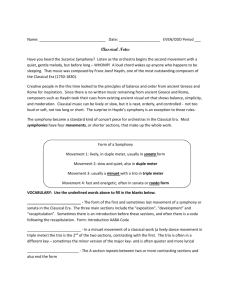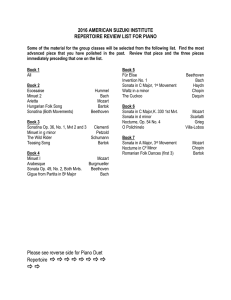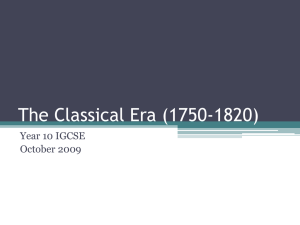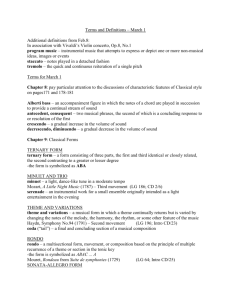21M011 (spring, 2006) Ellen T. Harris Lecture V
advertisement
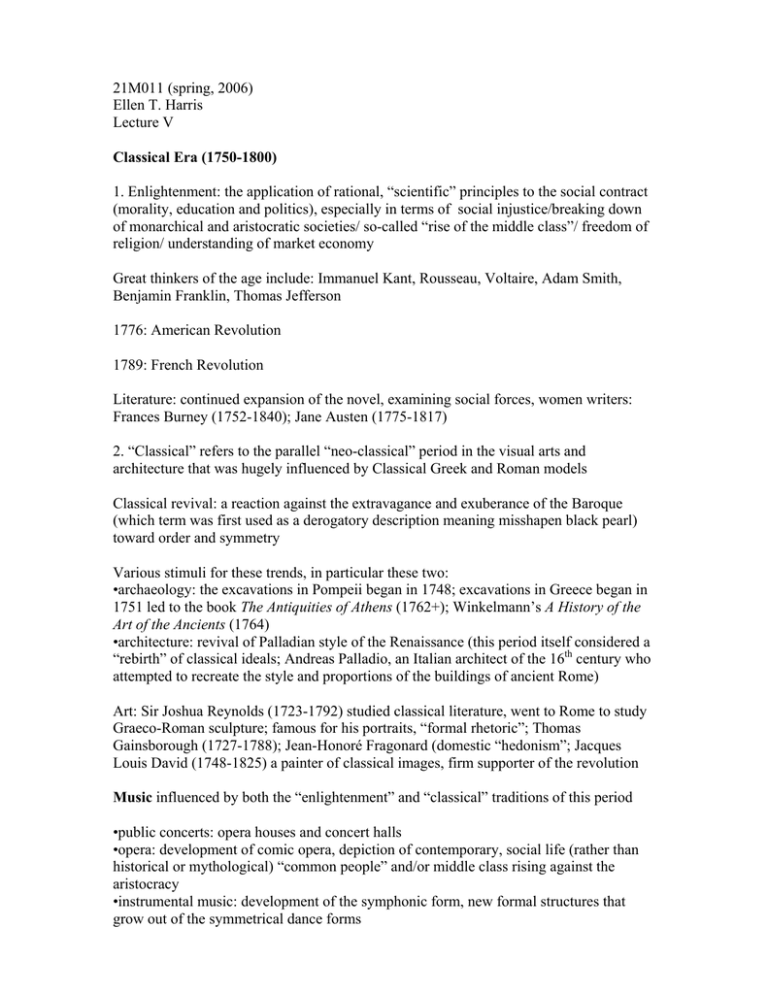
21M011 (spring, 2006) Ellen T. Harris Lecture V Classical Era (1750-1800) 1. Enlightenment: the application of rational, “scientific” principles to the social contract (morality, education and politics), especially in terms of social injustice/breaking down of monarchical and aristocratic societies/ so-called “rise of the middle class”/ freedom of religion/ understanding of market economy Great thinkers of the age include: Immanuel Kant, Rousseau, Voltaire, Adam Smith, Benjamin Franklin, Thomas Jefferson 1776: American Revolution 1789: French Revolution Literature: continued expansion of the novel, examining social forces, women writers: Frances Burney (1752-1840); Jane Austen (1775-1817) 2. “Classical” refers to the parallel “neo-classical” period in the visual arts and architecture that was hugely influenced by Classical Greek and Roman models Classical revival: a reaction against the extravagance and exuberance of the Baroque (which term was first used as a derogatory description meaning misshapen black pearl) toward order and symmetry Various stimuli for these trends, in particular these two: •archaeology: the excavations in Pompeii began in 1748; excavations in Greece began in 1751 led to the book The Antiquities of Athens (1762+); Winkelmann’s A History of the Art of the Ancients (1764) •architecture: revival of Palladian style of the Renaissance (this period itself considered a “rebirth” of classical ideals; Andreas Palladio, an Italian architect of the 16th century who attempted to recreate the style and proportions of the buildings of ancient Rome) Art: Sir Joshua Reynolds (1723-1792) studied classical literature, went to Rome to study Graeco-Roman sculpture; famous for his portraits, “formal rhetoric”; Thomas Gainsborough (1727-1788); Jean-Honoré Fragonard (domestic “hedonism”; Jacques Louis David (1748-1825) a painter of classical images, firm supporter of the revolution Music influenced by both the “enlightenment” and “classical” traditions of this period •public concerts: opera houses and concert halls •opera: development of comic opera, depiction of contemporary, social life (rather than historical or mythological) “common people” and/or middle class rising against the aristocracy •instrumental music: development of the symphonic form, new formal structures that grow out of the symmetrical dance forms Style features: Texture: essentially homophonic with lyric melody predominating; “classical counterpoint” included as a textural contrast within larger movements, used to heighten tension or increase forward flow, treated with great clarity of structure (more transparent) Harmony; slow harmonic rhythm; abandonment of basso continuo (harmony composed in inner parts as part of homophonic structure); less adventuresome harmonies and dissonances Rhythm: a marked change from earlier periods, where the rhythmic flow tends to set up a pulse or rhythmic pattern and maintain it; classical rhythms are varied, flexible, distinctive Melody: folk-like simplicity, song-like; organized into discrete phrases Form: rather than formal patterns that expand by multiplication (ritornello, ground bass); classical forms tend to expand hierarchically from within; expansion of rounded binary to sonata form Dynamics: variety and flexibility; wide gradations, carefully indicated Tone Color/Timbre: development of the “Classical orchestra”: abolition of the continuo, addition of middle range woodwinds (clarinets) and brass (horns) that complete the texture and harmony; again, flexibility in use of tone color Tempo: wider range of tempi and flexibility within single movements Today’s genre: Symphony (from the Greek: united in sound); sym-biosis (united in life); sym-pathy (united in feeling) Movements: sonata allegro, slow movement, minuet, rondo Wolfgang Amadeus Mozart Symphony 40 in G minor (1788), first movement K 2:15-20 Franz Joseph Haydn (1732-1809) Symphony 95 in C minor (1791) K 2:21-35 Variation form [recall “Kemp’s Jig”: aab form in improvised variations, where the repeated ‘a’ is also varied: aab a1a1′b1, a2a2′b2 a3a3′b3…… Classical music grows out of similar binary forms; but rather than expanding solely by multiplication, the classical binary form (or rounded binary) is expanded through internal and hierarchical elaboration Haydn Symphony 95, second movement, variation form (Kerman/Tomlinson, p. 189; K 2:22-26) Haydn’s music is typified by “continuous variation”; it is as if he could not leave a theme be without adding variety; his music, therefore, is continuously developing; this will be shown to be in direct contrast to Mozart, who seems not to have been able to stop creating new themes, so that rather than vary or develop he was just as likely to write something completely new aabb a1a2b1b1 a3b2b3(trans.) a a4 b4 coda beyond this linear form, listen to the larger, hierarchical form: aabb a1a2b1b1 a3b2b3(trans.) a a4 b4 coda A A′ B (minor) A′′ A′′′ A (theme) A′ (ornamented theme with added triplet sixteenth notes) B (developmental section in minor; added winds for tone color; alteration of underlying formal template) A′′ (compressed and elaborated repetition of AA′) A′′′ (coda) Minuet-trio form Haydn Symphony 95, third movement, minuet-trio (Kerman/Tomlinson, p. 193; K 2:2931) introduction of rounded binary (aaba) form [compare to the hierarchical form of the second movement]; note that b begins with a variation of a2 and that a′ begins with an exact repetition of a1 – Haydn is always playing with his themes minuet: a(=a1a2) :||: b(a2′b) a′(=a1coda) trio: c :||: dc′ minuet: a || ba′ Sonata form (see next page) Sonata forms (showing the use of continuing variation) rounded binary ||: a :||: b a :|| Mozart Symphony 40, first movement, sonata form (Kerman/Tomlinson, p. 185) ||: A (Exposition) A (T1kT1s b T2T2′tT1′C) 15 16 :||: B (Development) A′ (Recapitulation) :|| :||: B (T1′′T1iT1f) A′ (T1kT1s′ b′ T2′′T2′′′tT1′′′C′) Coda 17 18 19 20 Haydn Symphony 95, first movement, sonata form (Kerman/Tomlinson, p. 187) ||: A (Exposition) :||: B (Development) A′ (Recapitulation) || A (T1T1′ b T2T2′ C) :||: B (T1′′ T2′′ C′ T1′′′) A′ (T1′′′′ T2′′′ C′′) || 21 0:49 22 0:42 0:59 23 [T=Theme; C=Cadence theme; b=bridge; k=closing; t=little thematic transition; s=shortened; i=imitation; f=fragmented] :|| 21M.011 FORMAL PATTERNS 1. variation form A A' A'' A''' . . . (each A may be in rounded binary form; individual variations may be in secondary keys or in the opposite mode: major or minor) variations may be based on a melody or a bass theme/harmonic scheme 2. ternary forms a. simple ternary or song form A B A I X I b. rondo A B A C A . . . [coda] I X1 I X2 I or ABACABA ABCA etc. 3. binary forms a. simple binary form ||: a :||: b :|| I-X X-I b. rounded binary form ||: a :||: b a :|| I-X X-I c. sonata form ||: A [intro] T1-trans-T2-closing or or bridge cadence theme [intro] exposition I (tonic/ home key) X (second key) :||: B A :|| dev-retrans T1-trans-T2-closing [coda] development recapitulation [coda] modulation I ---------------- Symphonic form 1. 1st movement/ sonata allegro 2. slow movement a. binary b. ternary c. variation 3. minuet/trio; or scherzo/trio ||: a :||: b a :|| ||: c :||: d c :|| a || b a A ÆI B ÆX A ÆI minuet trio minuet (note: no sectional repetitions on the return of the minuet/scherzo) 4. rondo (or sonata/rondo) Concerto form (and also the movement scheme for most sonatas) 1. concerto: 1st movement, double-exposition form (Kerman/Tomlinson: 201) sonata: sonata form 2. slow movement 3. rondo repertory Mozart, Symphony No. 40 in G Minor (1st movt: sonata) Haydn, Symphony No. 95 in C Minor (4 movts: sonata, variation, minuet, rondo) Mozart, Piano Sonata in B-Flat, K. 570 (3rd movt: irregular rondo) Mozart, Piano Concerto in A (1st movt: double-exposition sonata form) Beethoven, Symphony No. 5 in C Minor (4 movts: sonata, variation, scherzo, sonata) Beethoven, String Quartet in F, Op. 135 (2nd movt: scherzo-trio) Chaikovsky (Tchaikovsky), Overture-Fantasy Romeo and Juliet (free sonata form) Brahms, Violin Concerto in D, Op. 77 (3rd movt: rondo) Mahler, Symphony No. 1 (3rd movt: irregular march-trio) Ravel, Piano Concerto in G (1st movt: compressed double-exposition sonata form) Bartok, Music for Strings, Percussion, and Celesta (2nd movt: sonata form)
